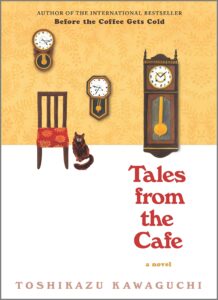 Tales From the Cafe by Toshikazu Kawaguchi
Tales From the Cafe by Toshikazu Kawaguchi Series: Before the Coffee Gets Cold #2
Genres: Adult, Contemporary Fiction, Fiction, Japanese Literature, Magical Realism
Published by Hanover Square Press Format: eBook
Pages: 145

The highly anticipated sequel to the international bestseller Before the Coffee Gets Cold, this book follows four new customers who hope to travel back in time in a little Japanese café.
In a back alley in Tokyo, there is a café that has been serving carefully brewed coffee for more than one hundred years. Local legend says that this shop offers something else besides coffee—the chance to travel back in time.
With faces both familiar and new, Tales from the Cafe follows the story of four customers who hope to take advantage of café Funiculi Funicula's time-travelling offer and revisit moments with family, friends and lovers. Each of them must face up to their past to move on with their life.
Kawaguchi's wistful and heartwarming new novel once again invites the reader to ask themselves, What would you change if you could travel back in time?
Book #2 in the Before the Coffee Gets Cold series, I picked this up with the hope that it would be a more refined and improved version of the stellar premise introduced in book #1 of the anthology series that I felt was hindered by lackluster execution. While I did find that it introduced more creative and ambitious stories, ultimately it largely feels like the same misguided experience which I’m unfortunately not a fan of.
Much like Before the Coffee Gets Cold, Tales From the Cafe feels like a slow and thoughtful reflection on one’s regrets and “what if’s”. Similar to book #1, the cafe Funiculi Funicula’s timeless setting is still quite an aesthetic location that lends itself perfectly to the premise of time travel. Based on context clues and the presence (or lack of) of certain characters, Tales From the Cafe takes place roughly seven years after the events of Before the Coffee Gets Cold. I found that the four short stories were at their best when it connected the four focal time-travelers to characters featured in previous stories, particularly when it involved guests seeking to speak with characters who are no longer alive.
On the flipside, stories that were more standalone in nature felt weaker and less interesting. For me, this was attributed to the characters beginning to blend together and failing to be distinctive enough in personality. Despite having a child and a completely different career, I was confused for a good 30 pages whether Kyoko was the same nosy lady as in book #1. It turned out she was not the same character (that was Hirai who is briefly mentioned in the 4th story) but the fact that I couldn’t tell them apart is a sign of weak character writing. A common trend in each story is that the focal character is introduced, a backstory is given, and we’re told by the author what the character’s personality is rather than experiencing it first-hand through their dialogue or actions. These backstories are also unnecessarily long and filled with details that have no relevance to the character’s persona such as specific clothes and colors they’re wearing (unless it’s to show their career or plain aesthetic), what they do for a living and where they went to school (sometimes this is relevant, most times it is not). Most of the information is things you would be given at a social mixer meet and greet event at a surface level which feels like a waste of pages in an already short book.
The time and pages could’ve instead been spent on the actual coffee-drinking sequence which feel far too short and undeveloped similar to book #1. Book #2 suffers from the exact same issues where characters start bawling and sobbing out of the blue right on cue for dramatic impact. However the build-up to these moments or the growing emotion that would typically be expected for these moments are still non-existent which makes them feel hysterical and utterly unrealistic. I had a note where it felt like characters would do a 180 degree flip as soon as they start drinking their coffee in book #1. This is slightly improved here but it’s still far from being solid. The reflection on the characters’ conversations post-time-travel also consistently felt surface level in discussion and incredibly brief with the only decent point covered in story #3 (easily my favorite both in this book and the series so far, though that’s not saying much).
One positive note is that the four stories are much more creative and ambitious in concept than the first book. Three of the four short stories involved a character wishing to speak to a character who was no longer alive (this only happened once in the book #1), one story involved a character time-traveling into the future, and one of them involved the largest time jump so far at 30 years (our main cafe waitress Kazu wasn’t even born yet). The last story involving a three decade jump also benefited from the appearances of both current and past cafe staff for some interesting discoveries related to Kazu’s family and female cafe ghost. However as previously mentioned, the actual execution of these stories leaves a lot to be desired and even the most intriguing moments still feel devoid of interest, or worse, bordering into ridiculous (the entirety of story #1, the entire issue could be solved by the character having an honest conversation with someone very much alive). There were distinctive parts that were clearly intended to be a thought-provoking and moving moment that fell flat with a “no duh that’s common sense” reaction and it felt like every character didn’t have a single ounce of intuition or social/emotional IQ. Perhaps the lack of nuance with the character dialogue could be partly attributed to the book being a translated work vs being read in the native Japanese language. Still, it’s impossible to not feel the huge missed opportunities everywhere in the story and dialogue..
A good deal of my distaste for this series could also be attributed to how conservative and old-fashioned the writing and characters are. While not necessarily a drawback, both novels feel heavily based and catered towards Japanese culture which can be hit or miss to Western readers (makes sense since it’s obviously written for Japanese readers). Being Japanese-American (albeit quite American being 4th generation) it’s easy for me to recognize the stark differences in culture that affects various aspects of this series (at least in the older Japanese population and past generations). A lot of female characters are expected to marry young, have children, make their husbands happy, and deviations from this norm causes internal discussions and reservations amongst both male and female characters. Female characters in particular fall into either one of two categories; either gossipy, shallow, and decidedly single, or caring, motherly, mild-mannered and the ideal wife material. Story #3 in particular features a story involving marriage and death with a character insisting that the other find love and marriage if the current one doesn’t last. This story acknowledges and reflects that one can be happy without being married, however this entire arc is one that clearly holds more relevance and weight to Asian cultures. The work life balance imbalance stereotyped in Japanese work culture is also prevalent everywhere and is even encouraged by certain narratives such as story #2 with the apprentice potter.
For better or for worse, Tales from the Cafe read nearly the same as Before the Coffee Gets Cold for me with a few minor improvements. However the reading experience was still frustratingly the same and all of the negative drawbacks I had with the first book were still very much present in book two (the only difference is that I expected it this time which was less confusing and more dull a 2nd time around). There are two (soon to be three) sequel books left in the series but I’ll leave it to one of my friends to finish reading them and paraphrase any conclusion (if there’s any at all) to the long-running cafe mysteries as two swings and two misses is where I throw in the towel. The coffee brewing and sipping descriptions are nice though-
